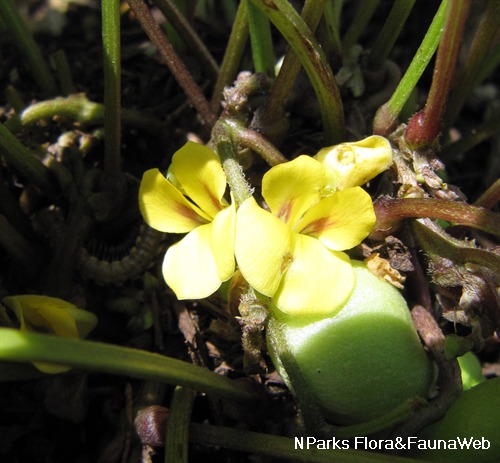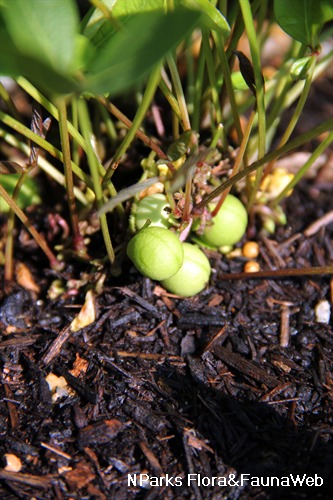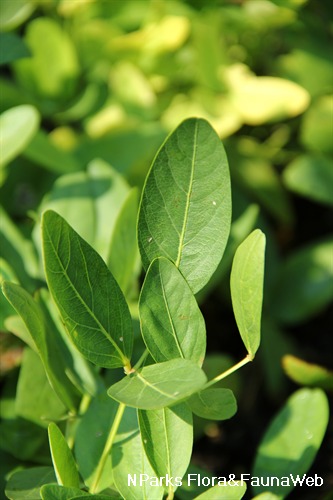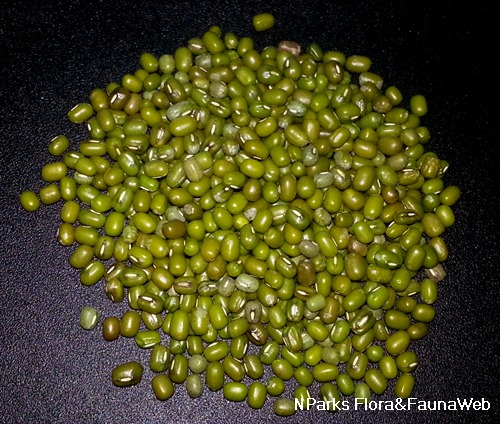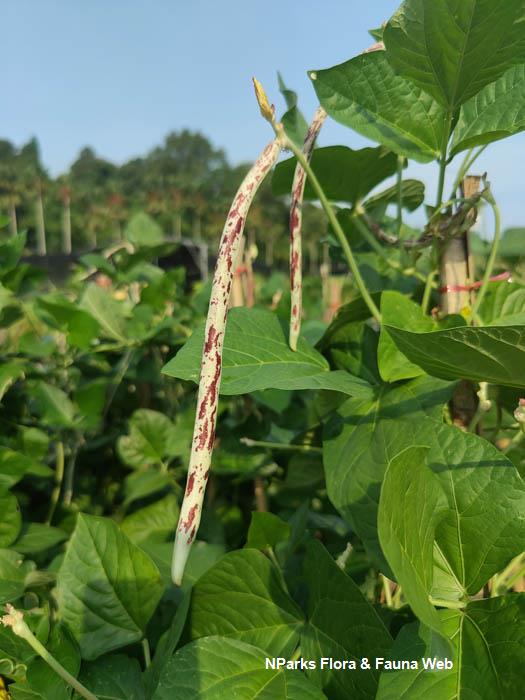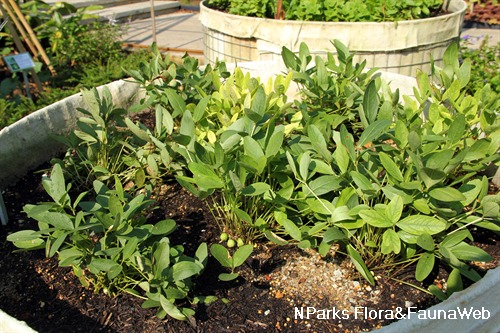
Back
Vigna subterranea (L.) Verdc.
| Family Name: | Fabaceae (Leguminosae) |
| Common Name: | Earthpea, Bambara Groundnut |
Name
Classifications and Characteristics
| Plant Division | Angiosperms (Flowering Seed Plants) |
|---|---|
| Plant Growth Form | Shrub |
| Lifespan (in Singapore) | Annual |
| Mode of Nutrition | Autotrophic |
Biogeography
| Native Distribution | Africa |
|---|---|
| Native Habitat | Terrestrial |
| Local Conservation Status | Non-native (Horticultural / Cultivated Only) |
Description and Ethnobotany
| Growth Form | Annual herb with creeping or mounded growth form. |
|---|---|
| Foliage | Pinnately trifoliate leaves are composed of 3 oval, hairless leaflets. Terminal leaflet (6 cm long, 3 cm wide) is slightly larger than lateral leaflets. |
| Flowers | Butterfly-shaped flowers are initially yellowish white, turning yellow and then light brown. |
| Fruit | Fruits are indehiscent pods (up to 3.7 cm long) which typically mature underground. Most varieties produce 1-seeded pods, while some plants collected in the Congo are 3-seeded. |
| Ethnobotanical Uses | Edible Plant Parts : Edible Seeds Food (Fruit or Vegetable): In Sub-Saharan Africa, this species is widely grown for its nutritious seeds which are rich in carbohydrates (65%) and protein (18%). Immature seeds are eaten boiled with salt. Seeds are also dried and pounded to make flour that is used in cakes or porridge. |
Landscaping Features
| Landscape Uses | Parks & Gardens, Groundcover |
|---|---|
| Thematic Landscaping | Economic Garden |
Plant Care and Propagation
| Light Preference | Full Sun |
|---|---|
| Water Preference | Moderate Water |
| Rootzone Tolerance | Drought Tolerant, Poor Infertile Soils |
| Propagation Method | Seed, Division |
| Propagation Ease | Difficult |
| Propagule Establishment Remarks | The seeds must be dried and stored under optimal conditions for adequate shelf life and germination rate. (http://www.kew.org/science-research-data/kew-in-depth/difficult-seeds/species-profiles/vigna-subterranea/index.htm) |
Foliar
| Mature Foliage Colour(s) | Green |
|---|---|
| Foliar Type | Compound (Trifoliate) |
| Foliar Arrangement Along Stem | Alternate |
| Foliar Attachment to Stem | Petiolate |
| Foliar Shape(s) | Non-Palm Foliage (Oval) |
| Foliar Venation | Pinnate / Net |
| Foliar Margin | Entire |
| Foliar Apex - Tip | Acute |
| Foliar Base | Acute |
Floral (Angiosperm)
| Flower & Plant Sexuality | Bisexual Flowers |
| Flower Colour(s) | Brown, Yellow / Golden |
|---|---|
| Flower Grouping | Cluster / Inflorescence |
| Flower Symmetry | Bilateral |
| Individual Flower Shape | Papilionaceous / Pea-shaped |
| Flower Transitional Changes | Colour |
| Flower Colour(s) Remarks | Yellowish White |
Fruit, Seed and Spore
| Fruit Classification | Simple Fruit |
|---|---|
| Fruit Type | Dehiscent Dry Fruit , Legume / Pod |
Image Repository
Others
| Master ID | 31757 |
|---|---|
| Species ID | 6156 |
| Flora Disclaimer | The information in this website has been compiled from reliable sources, such as reference works on medicinal plants. It is not a substitute for medical advice or treatment and NParks does not purport to provide any medical advice. Readers should always consult his/her physician before using or consuming a plant for medicinal purposes. |

